

Enchanting Hokkaido:
A Special Flower Tour Feature
Encounter the seasonal blossoms set against the magnificent landscapes of Hokkaido.
From spring through fall, Hokkaido is carpeted with a tapestry of flowers, with varieties blooming in succession across the region, each passing the baton to the next as the seasons change. Even in winter, ethereal frost flowers appear in specific conditions. Hokkaido is home to vast flower fields that stretch as far as the eye can see and rare flowers that bloom only on its remote islands. Flower enthusiasts have a plethora of spots to explore!
Don’t hesitate and embark on a heartwarming journey to discover Hokkaido’s blooming treasures.
※The blooming periods may vary yearly due to climate conditions. Please check the official websites for the latest blooming status.
Spring
-
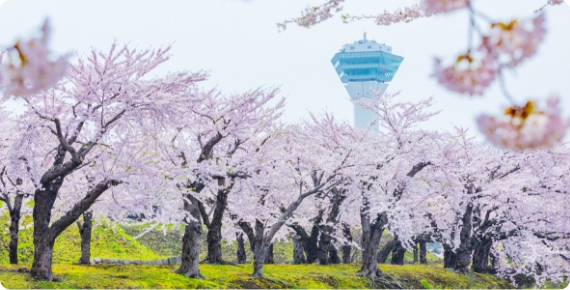
Cherry Blossoms (Late April to Mid-May)
Cherry blossoms signal the arrival of spring, reaching full bloom from late April to mid-May in the colder climate of Hokkaido. The best viewing times differ by region within Hokkaido, with Hakodate and Matsumae typically from late April, areas near Sapporo from early May, and the Eastern Hokkaido area from mid-May. Hokkaido's cherry blossoms are characterized by their vivid pink color. Visitors can also enjoy viewing different species and endemic varieties not found in Honshu.
A Spot to Enjoy Cherry Blossoms -
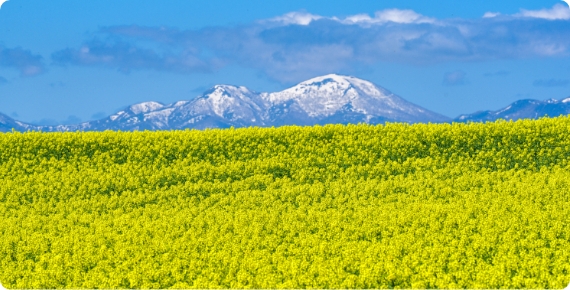
Rape Blossoms (Late May)
The bright yellow rape blossoms spread like a carpet, reaching their peak in late May in Hokkaido. Takikawa City, known as one of Japan's leading rapeseed oil producing areas, sees its vast fields of rape blossoms turn a vibrant color in spring. Festivals are held to coincide with the blooming period, drawing crowds to enjoy the fields.
A Spot to Enjoy Rape Blossoms -
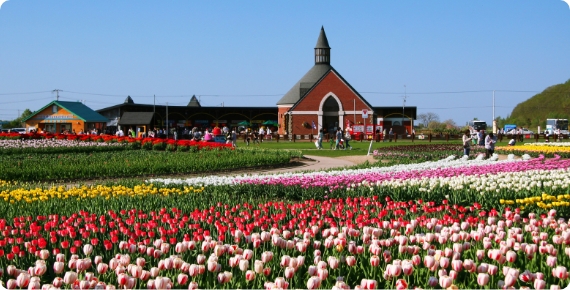
Tulips (May to June)
Tulips, familiar for their colorful and cute shapes in red, white, yellow, and other colors, have their season from May to June in Hokkaido. Various tulips are planted across Hokkaido, and at Kamiyubetsu Tulip Park in the Okhotsk region, about 200 varieties of tulips bloom across the extensive grounds.
A Spot to Enjoy Tulips -
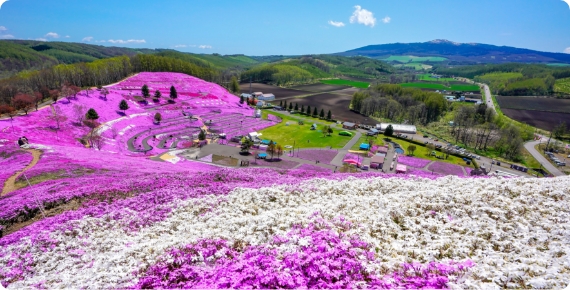
Moss Phlox (Early May to Early June)
Moss phlox is called so because its delicate cherry blossom-like flowers cover the ground like moss. Starting around May each year, pink and white small flowers continue to bloom for about a month, enveloping the surroundings with a sweet fragrance. Hokkaido is home to famous moss phlox spots, boasting overwhelming scales. Gentle rolling hills are dyed in a vivid pink gradient.
A Spot to Enjoy Moss Phlox -
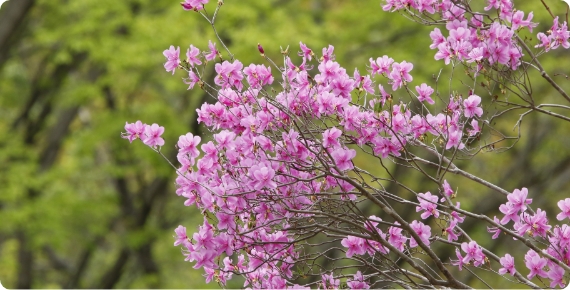
Azaleas (Early May to Early June)
Azaleas, familiar as garden shrubs and street trees, bloom in vivid colors like pink and red. In Hokkaido, they bloom from early May to early June, with the Ezo Murasaki Azalea being the most common, native only to Hokkaido. The large colony at Onneyu Onsen in Kitami City is designated as a natural monument of Hokkaido and is a popular spot that can be visited only during the blooming period.
A Spot to Enjoy Azaleas
Lilacs (Mid-May to Early July)
Lilacs, beloved by the citizens of Sapporo to the extent of being seen in gardens throughout the city, have been selected as the "Tree of Sapporo." Also called lilac, this rare shrub, seldom seen outside Hokkaido in Japan due to its vulnerability to high temperatures and humidity, blossoms with small purple or white flowers clustered at the tips of its branches.
A Spot to Enjoy LilacsSummer
-
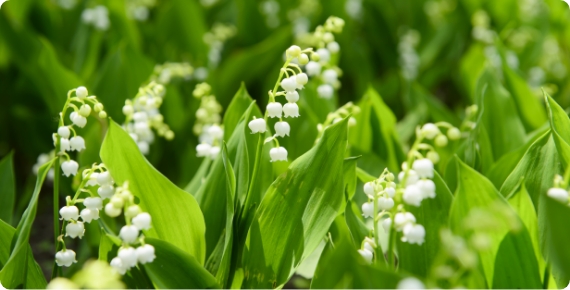
Lily of the Valley (Late May to Mid-June)
Lily of the valley prefers shade and well-ventilated areas due to its intolerance of heat. It naturally grows in highlands, blooming delicate white flowers beneath large leaves. At the foot of Mt. Horoshiri in Biratori Town, wild lilies of the valley form large colonies, the largest in Japan. They are open to the public for about a month from late May to mid-June, where visitors can enjoy the bell-shaped flowers swaying like bells.
A Spot to Enjoy Lily of the Valley
Alpine Plants (April to September)
Hokkaido, with its cooler climate, is a treasure trove of alpine plants. Plants that are typically only seen in alpine zones in Honshu can be found even in lowland areas here. The summer season is especially recommended. Rebun Island, the northernmost island of Japan, also known as the "floating island of flowers," sees about 300 species of alpine plants bloom during this time. Especially, species with "Rebun" in their names, such as Rebun Atsumorisou, endemic to Rebun Island, are a must-see.
A Spot to Enjoy Alpine Plants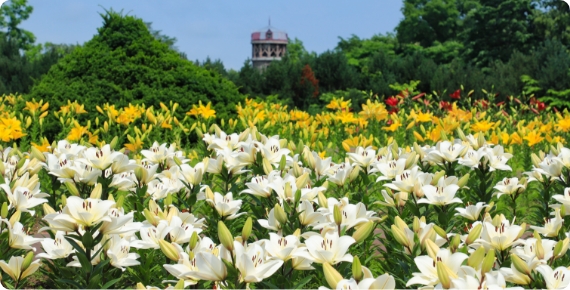
Lilies (Mid-June to Early September)
Summer in Hokkaido is the most vibrant season, with many flowers blooming in competition. The season for lilies spans from early summer to summer. At Yurigahara Park in Sapporo, about 100 species of lilies bloom over three months. The Ezo Skashi Yuri, almost exclusively seen in Hokkaido, has its season in June. Don't miss it!
A Spot to Enjoy Lilies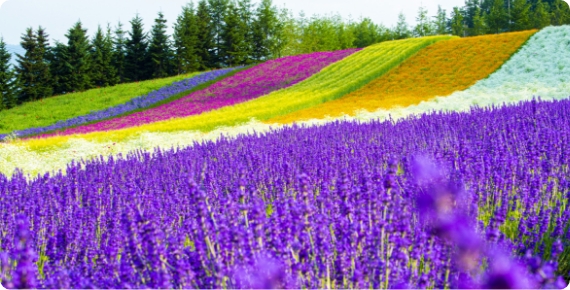
Lavender (Mid-July to Mid-August)
Waves of vivid purple lavender fields symbolize the summer of Hokkaido. Furano, famous as the town of lavender, attracts a million tourists every year with its pleasant fragrance. The flowering time varies by variety, with late bloomers lasting until mid-August, though the peak is usually in mid-July.
A Spot to Enjoy Lavender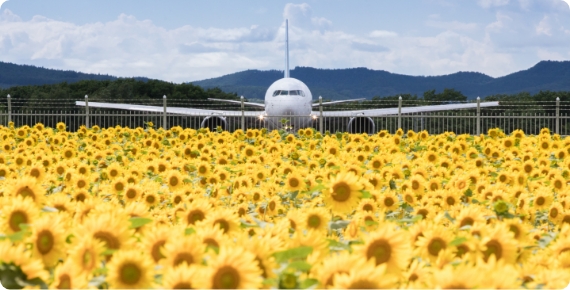
Sunflowers (Late July to Early October)
Sunflowers, alongside lavender, represent the summer of Hokkaido. Under the refreshing blue sky, sunflowers gleaming golden bask in the summer sunlight, decorating the land of Hokkaido. At Memanbetsu Airport, the gateway to Okhotsk, about 400,000 sunflowers greet tourists during the summer holidays, making for photogenic scenes as if planes are landing in the sunflower fields beside the runway.
A Spot to Enjoy SunflowersAutumn
-

Cosmos (Late August to Late September)
Cosmos, which bloom as the days shorten, are also known as "autumn cherry blossoms" in kanji. While pink is the color most commonly associated with cosmos, there are varieties that bloom in orange and yellow. Engaru Town hosts one of Japan's largest cosmos fields, known as a famous spot where about 20 varieties and 10 million cosmos flowers bloom.
A Spot to Enjoy Cosmos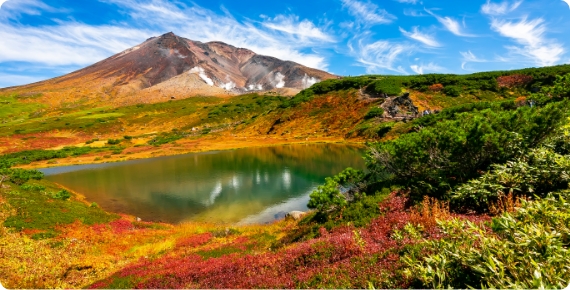
Autumn Leaves (Mid-September to Early November)
The autumn leaves in Hokkaido, with its large temperature differences, are known for their vivid and colorful appearance. In the Daisetsuzan mountain range, where mountains of 2,000 meters elevation are lined up, the coloring starts from around late August, reaching the best viewing time in mid-September. The coloring gradually moves southward, with the best viewing time in Hakodate around late October, offering the longest period for enjoying autumn leaves in Japan.
A Spot to Enjoy Autumn LeavesWinter
-

Frost Flowers (Early January to Mid-February)
Frost flowers, a natural phenomenon that appears on frozen lake surfaces in the early mornings of the cold season, are also known as "winter flowers," resembling flower-like ice crystals. Seen in lakes such as Lake Akan and Lake Kussharo, frost flowers are not always visible and only appear under certain meteorological conditions, making them a miraculous flower field to witness at least once.
A Spot to Enjoy Frost FlowersFlower-Viewing Highlights Map
A Model Course for Exploring Flowers
-
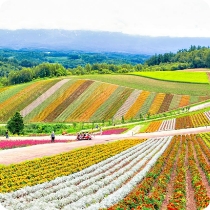
Three-Day Road Trip to Some of Hokkaido’s Best Greenery Spots
#New Chitose Airport #Obihiro Airport
-
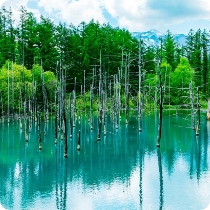
Head for Furano and Biei’s Hills of blooming summer flowers
A 4-Day trip through New Chitose to Asahikawa#New Chitose Airport #Asahikawa Airport
-

A 5-day trip trekking and venturing out in the remote islands of the northernmost area of Japan
#Asahikawa Airport #Wakkanai Airport





